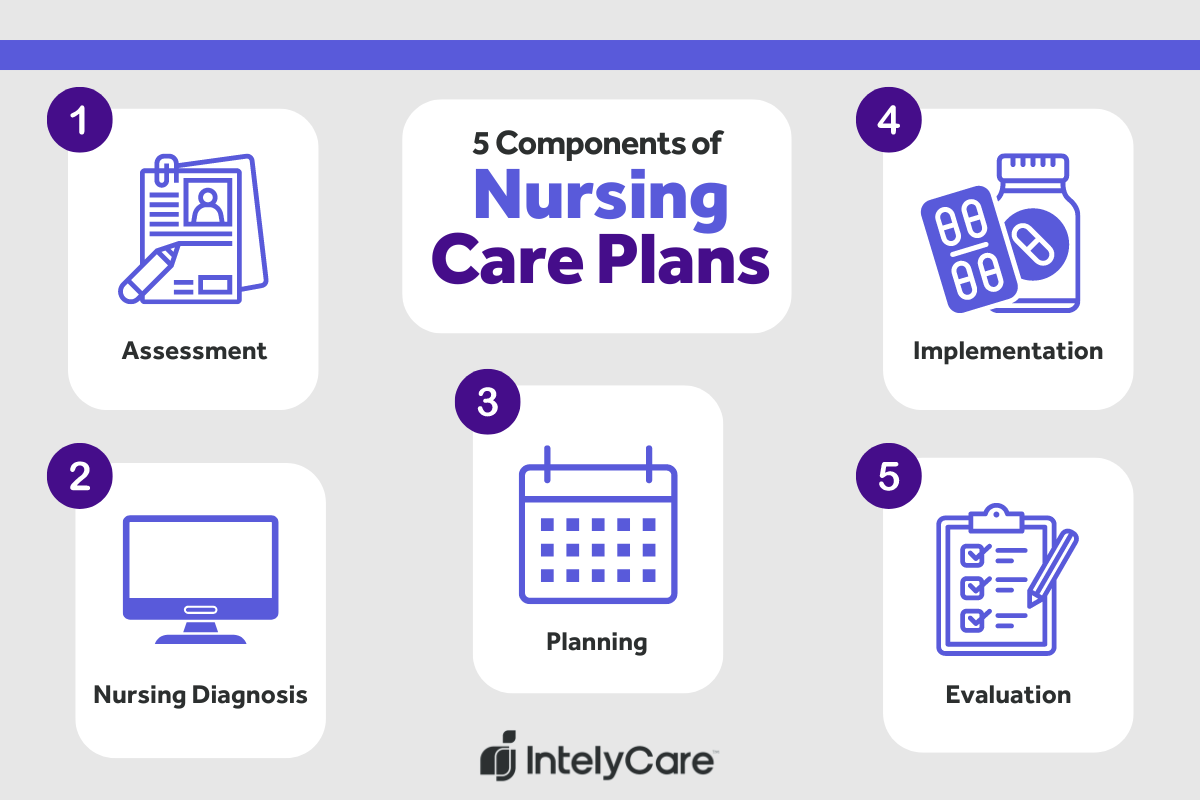Nursing Care Plans: Overview and Writing Tips

If you’re a nursing student or you’re completing your prerequisites, you might be wondering, What is a plan of care in nursing? Nursing care plans are different from medical plans because nurses use a different set of diagnoses to guide care. They help nurses bridge the gap between medical treatments and patient well-being while standardizing care for patients.
Care plans are an essential part of the nursing process. Critical thinking, patient-centered treatment approaches, goal-oriented tasks, and evidence-based practice are the basis for quality nursing care. Nursing care plans aim to standardize care, so that you have a way to organize your shift and patients get the best outcomes possible.
If you’ve spoken to practicing nurses, you might have heard that they don’t use care plans much. Many electronic medical records (EMRs) — like Epic charting systems — can generate care plans as part of standardized order sets. Once you finish nursing school, you might not write down your care plans anymore. But learning care plans and internalizing the nursing process is an essential foundation for nursing practice.
What Is a Nursing Care Plan?
These plans are a way of structuring your care for each patient — all the way from initial assessment and diagnosis to measuring outcomes and charting. In nursing school, you’ll probably get assigned care plans to show how you would provide care to different patients. Their specific structure helps you build up the habit of using the nursing process in patient care.
While they’re often assigned as written documents in nursing school, nursing care plans are constantly shifting in the real world. Plans change as patient statuses change; you might have a patient with a plan to promote food intake, but if they code, that won’t be your first priority anymore. It’s commonly said that nurses don’t use care plans in clinical practice, but in reality, they just become second nature.
Many EMRs now automatically generate nursing care plans, meaning you’ll check boxes on a screen when you complete tasks rather than use a paper and pen. For example, if a patient is newly diagnosed with diabetes, a nursing care plan focused on “Knowledge Deficit” could automatically populate on the EMR for you to chart on. These serve as reminders for interventions and help you chart what you’ve done.

5 Components of a Nursing Care Plan
Nurse care plans follow a specific formula, and every step-by-step nursing care plan has five parts:
1. Assessment: The foundation of any nursing care plan starts with a thorough assessment of the patient’s physical, psychological, social, and environmental factors. Nurses gather data through interviews, physical examinations, handoffs, and reviewing medical records.
2. Diagnosis: Based on the assessment, nurses identify the patient’s health problems, needs, and potential risks. Nursing diagnoses are distinct from medical diagnoses and focus on how the patient responds to health issues. There are four categories of nursing diagnoses, as outlined below.
3. Planning: Nurses collaborate with the patient, their family, and the healthcare team to set goals and establish a plan of care. This involves choosing appropriate interventions and outlining the expected outcomes or nursing implications.
4. Implementation: Nurses execute the care plan by performing interventions and treatments. This phase includes administering medications, providing therapies, educating patients, and addressing their physical and emotional needs.
5. Evaluation: Measuring outcomes is essential, as nurses compare the patient’s actual outcomes with the expected ones. If goals are met, the plan may continue or be modified as necessary.
Nursing Diagnoses: An Essential Part of Nursing Care Plans
Nursing diagnoses are standardized clinical judgements that guide nursing care. The North American Nursing Diagnosis Association International (NANDA) defines them as:
“a clinical judgment concerning a human response to health conditions/life processes, or a vulnerability for that response, by an individual, family, group or community. A nursing diagnosis provides the basis for selection of nursing interventions to achieve outcomes for which the nurse has accountability.”
Nursing diagnoses guide nursing care plans, but they’re different from medical diagnoses because they focus on the patient rather than the disease process. Nurses cannot medically diagnose patients, but you’ll use medical diagnoses to choose and guide your nursing diagnoses.
There are four types of NANDA nursing diagnoses:
- Health-problem focused: patient issues or problems that you observe during your assessment
- Risk diagnosis: problems that could develop without nursing interventions
- Health-promotion diagnosis: clinical judgments about a patient’s ability to promote their own wellness
- Syndromes: clinical judgments relating to how diagnoses relate to one another, and how a nurse could intervene on several diagnoses at once
In each care setting, there are nursing diagnoses that you’ll see more often than others. Care plans help you build an association between nursing diagnoses and nursing interventions, so you can implement the right interventions when they’re appropriate.
For example, in med-surg units, a common nursing diagnosis is “risk for falls.” After writing a care plan, you’ll know that patients with this diagnosis should receive falls prevention education, a bed monitor, and be transferred to a room near the nurses’ station.
How to Write Nursing Care Plans
Nursing care plans follow a standardized formula, and you might refer to NANDA’s publications while writing care plans in nursing school. Follow these steps to learn the flow of a nursing care plan:
1. Assess Your Patient
This includes reviewing medical records, a physical assessment, and interviewing the patient. From these findings, you’ll identify the patient’s health problems, acute needs, and potential risks. Consider their medical history, current medical diagnoses, medications they’re on, and any cultural and psychosocial factors that may impact their care.
2. Nursing Diagnosis
Using the data you gathered during the assessment phase, you’ll choose NANDA nursing diagnoses that fit your patient. They should be clear, specific, and focused on the patient’s response to health issues. Remember that medical diagnoses cannot be nursing diagnoses, but you’ll use them to create your nursing care plan.
Write out your nursing diagnoses using this formula:
- A problem statement, which includes the patient’s health problem
- Etiology or risk factors, which describe the possible reasons for the problem developing
- Defining characteristics, which are symptoms that allow for a nursing diagnosis. (Risk factors are used instead if you’re writing a risk-based nursing diagnosis.)
Here’s an example nursing diagnosis using NANDA’s guidelines:
“Impaired skin integrity (problem), related to pressure ulcer on sacral area (etiology), as evidenced by erythema and warmth over sacral area as well as open wound and visible tissue damage (defining characteristics).”
3. Planning
You’ll plan the nursing interventions, education, and outcomes you expect. Every care plan should involve the patient, their family, and the rest of the healthcare team. You’ll need to prioritize your interventions based on a patient’s most acute needs and potential risks.
4. Implementation or Intervention
List out the implementation actions that you’ll do to help the patient achieve their goals. This might include nursing interventions like patient education, promoting fluid intake, or feeding assistance. You’ll document each intervention, including the time you did them and the patient response.
5. Evaluation
Assess — and continue to assess — the patient’s outcomes after intervention. Be sure to document whether the goals are met, where they fell short, or where goals should be adjusted. Modify your care plan based on the outcomes you observe. Keep patients and family in the loop to avoid lost progress after discharge.
NANDA Nursing Care Plan Examples
Each nurse care plan example focuses on a different nursing diagnosis — explore our in-depth article about how to create a nursing care plan for dementia — but in reality, most patients will have several nursing diagnoses that you’ll manage at once.
Nursing Care Plan for Pain
Assessment: You’re working in the emergency department, and a 25-year-old male patient comes in with acute leg pain after falling off his skateboard. He presents with a visibly deformed left lower leg, he can’t bear weight on it, and he reports a pain rating of 8/10. His left leg appears swollen, bruised, and deformed at the midshaft of the tibia. His blood pressure is 125/82, his pulse is 87 beats per minute, and he’s breathing at a rate of 16 breaths per minute. After an X-ray, the physician confirms his left tibia is fractured.
Diagnostic Statement: Acute pain related to a fractured left tibia secondary to a skateboarding accident, as evidenced by a self-reported pain rating of 8/10 and an increased respiratory rate of 16 breaths per minute.
Planning:
- Interventions: You plan to treat his pain using prescribed PRN pain medications, immobilize the leg to prevent pain exacerbation, and administer an ice pack to mitigate swelling.
- Education: You’ll teach this patient about the pain medication you administer, as well as how often they can receive it, and expected outcomes. You also educate him on cold treatment for fractures and why immobility is essential for fracture stabilization.
- Outcomes: You expect these interventions to bring his reported pain level down to a 5/10 and his breathing rate to within normal limits.
Interventions:
- You give the patient the ordered morphine, 15mg PO every 4 hours.
- You bring an ice pack into the room and instruct him to hold it on his left lower leg.
- You advise him not to bear weight on the leg and to call you for a urinal if he needs to use the bathroom.
Outcomes: You reassess his pain in 30 minutes, and he rates it at a 6/10. His breathing has decreased to 8 breaths per minute, and he continues to hold the ice pack on his leg. You’ll continue to monitor and administer pain medication as appropriate.
Nursing Care Plan for Fever
Assessment: You work in a family medicine practice, and a father brings in a female six-month-old for a fever. She is actively crying, her skin is flushed and warm, and her rectal temperature is 101.4F. Her breathing and heart rate are elevated at 42 breaths per minute and 164 beats per minute, respectively.
Diagnostic Statement: Hyperthermia with unknown origin, as evidenced by rectal temp of 101.4 and flushed, warm skin.
Planning:
- Interventions: You plan to administer prescribed antipyretic medications to reduce fever. You’ll also help the father remove any extra clothing layers since these can contribute to high body temperature.
- Education: You educate the father to provide optimal hydration when body temperature is elevated. If her fever rises past 104º F, you advise him to take her to an emergency department.
- Outcomes: You expect these interventions to reduce her fever to below 100.4º F, and bring her pulse and breathing rates down to within normal limits.
Interventions:
- You administer the prescribed acetaminophen according to her weight dosage.
- You provide an extra sippy cup to be sure she has adequate fluid intake.
- You assist the father in removing any unnecessary clothes, such as booties or caps.
- You educate the father on optimal hydration, signs of worsening status, and when to go to the emergency department for more acute care interventions.
Outcomes: Within 40 minutes, her rectal temperature has reduced to 99.8º F and her pulse is 135 beats per minute, but her breathing is still slightly elevated. She is still crying, but is no longer flushed, and the father verbalizes he feels ready to bring her home for a nap.
Use Nursing Care Plans in Clinical Practice
Looking to put your care plans to work in real life? Explore opportunities to build the kind of career you always planned for. Learn how you can get matched with nursing jobs in your specialty and location on IntelyCare today.

